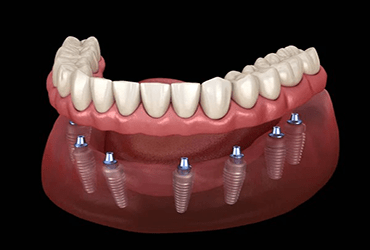Digital Dentistry in Full Arch Rehabilitation:
Digital dentistry has opened the horizons of dentistry and one of the main benefactors is full mouth rehabilitation or the restoration or replacement of an entire arch of teeth. Digital technologies have enhanced the precision, efficiency, and predictability of these procedures. Some key applications of digital dentistry in implant supported full mouth rehabilitation are:
- DIAGNOSIS THROUGH 3D IMAGING: Cone-beam computed tomography (CBCT) and other 3D imaging technologies provide detailed, high-resolution images of the entire oral and facial structures. These images are essential for accurate diagnosis, treatment planning, and the assessment of bone quality and quantity for implant placement.
- DIGITAL IMPRESSIONS: Today, intraoral scanners have largely replaced traditional impression materials like alginate or silicone. This technology allows for faster and more accurate data collection, reducing patient discomfort and the need for retakes.
- Computer-Aided Design (CAD): CAD software is used to design crowns, bridges, and full arch prostheses with precision. Dentists can customize the shape, size, and fit of restorations, ensuring optimal aesthetics and functionality. This technology also enables better communication with dental laboratories.
- Computer-Aided Manufacturing (CAM): After designing the restorations in CAD, CAM technology is employed to fabricate them. This can include milling or 3D printing of crowns, bridges, and implant-supported prostheses. CAM ensures the restorations are precisely crafted according to the digital design.
While these are the most used aspects of digital dentistry in a regular practice today, the tenets of digital dentistry can be applied over a vast spectrum of dental treatments, ranging from smile designing to dental implant guides. Let us explore some of these:
- Guided Implant Surgery: Guided implant placement involves using 3D images and CAD/CAM technology to create surgical guides that precisely position dental implants. This reduces surgery time, minimizes trauma, and enhances the predictability of implant success.
- Virtual Articulation: Digital dentistry allows for virtual articulation of the patient’s jaw movements, enabling more accurate occlusion and bite registration. This is crucial for full arch rehabilitation to ensure that restorations fit correctly and function properly.
- Digital Workflow Integration: Many digital systems and software platforms are integrated, allowing for a streamlined digital workflow. This facilitates communication between dentists, prosthodontists, and dental technicians, improving collaboration and the overall treatment outcome.
- Immediate Loading: Digital planning and guided surgery techniques can allow for immediate loading of dental implants, where the final prosthesis is attached shortly after implant placement. This minimizes downtime for patients and enhances esthetic outcomes.
- Virtual Smile Design: For esthetic full arch rehabilitation cases, virtual smile design software allows patients and clinicians to visualize the expected results, which can help set appropriate expectations and improve patient satisfaction.
The application of digital dentistry in full arch rehabilitation offers multiple advantages, including increased precision, reduced treatment times, improved patient comfort, and enhanced esthetic outcomes. Dentists and prosthodontists are increasingly adopting these technologies to provide higher quality and more predictable results in full arch rehabilitation cases.

